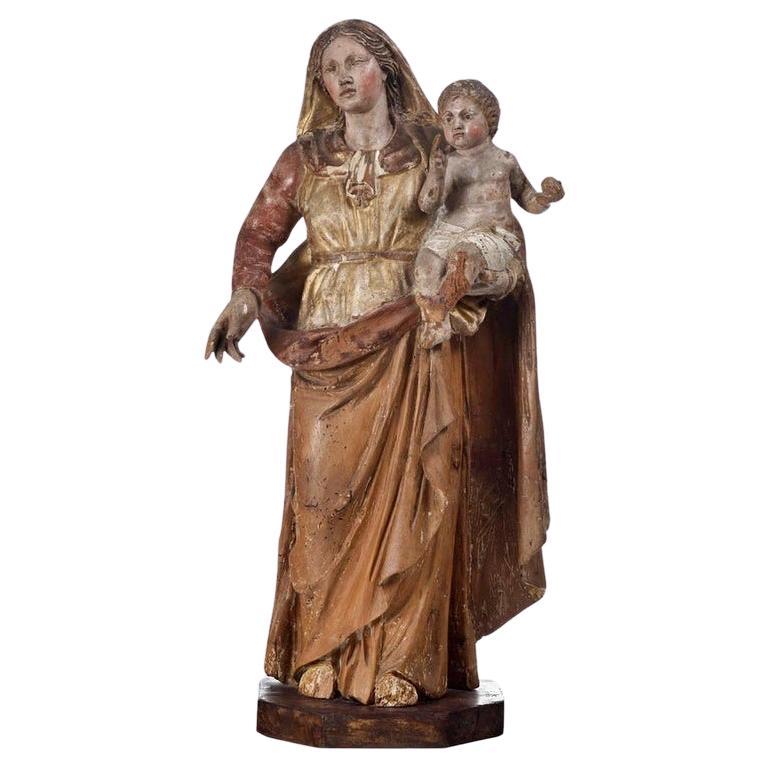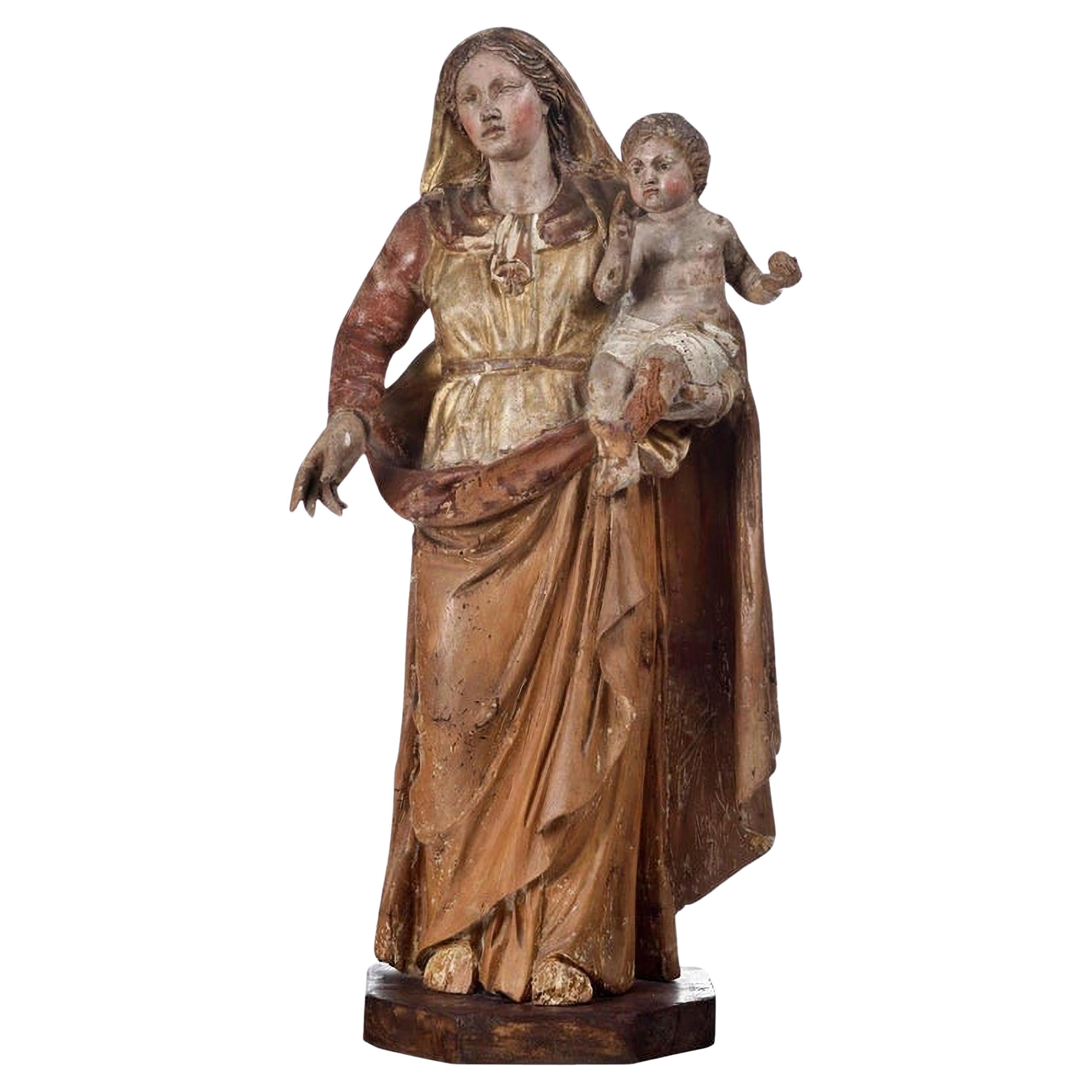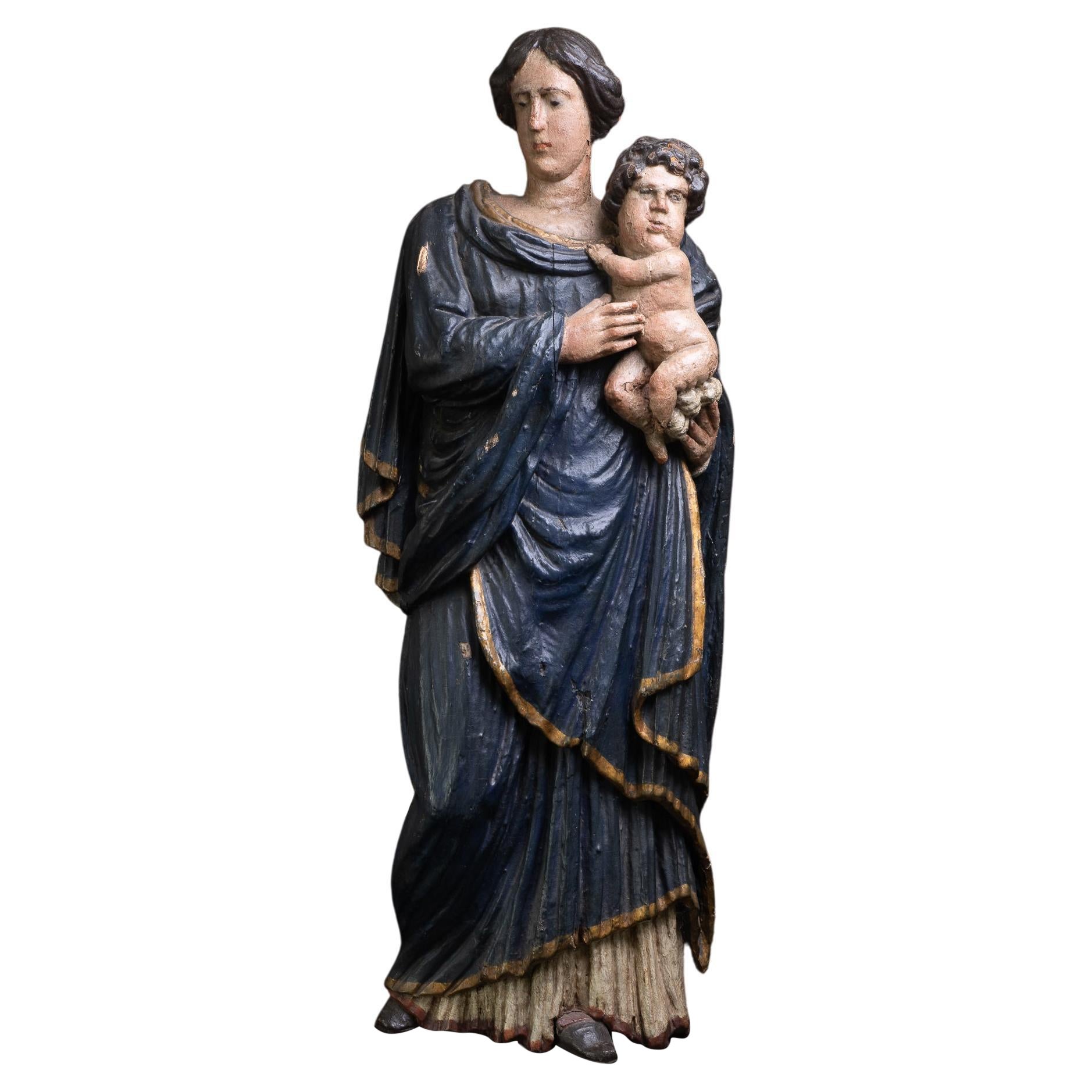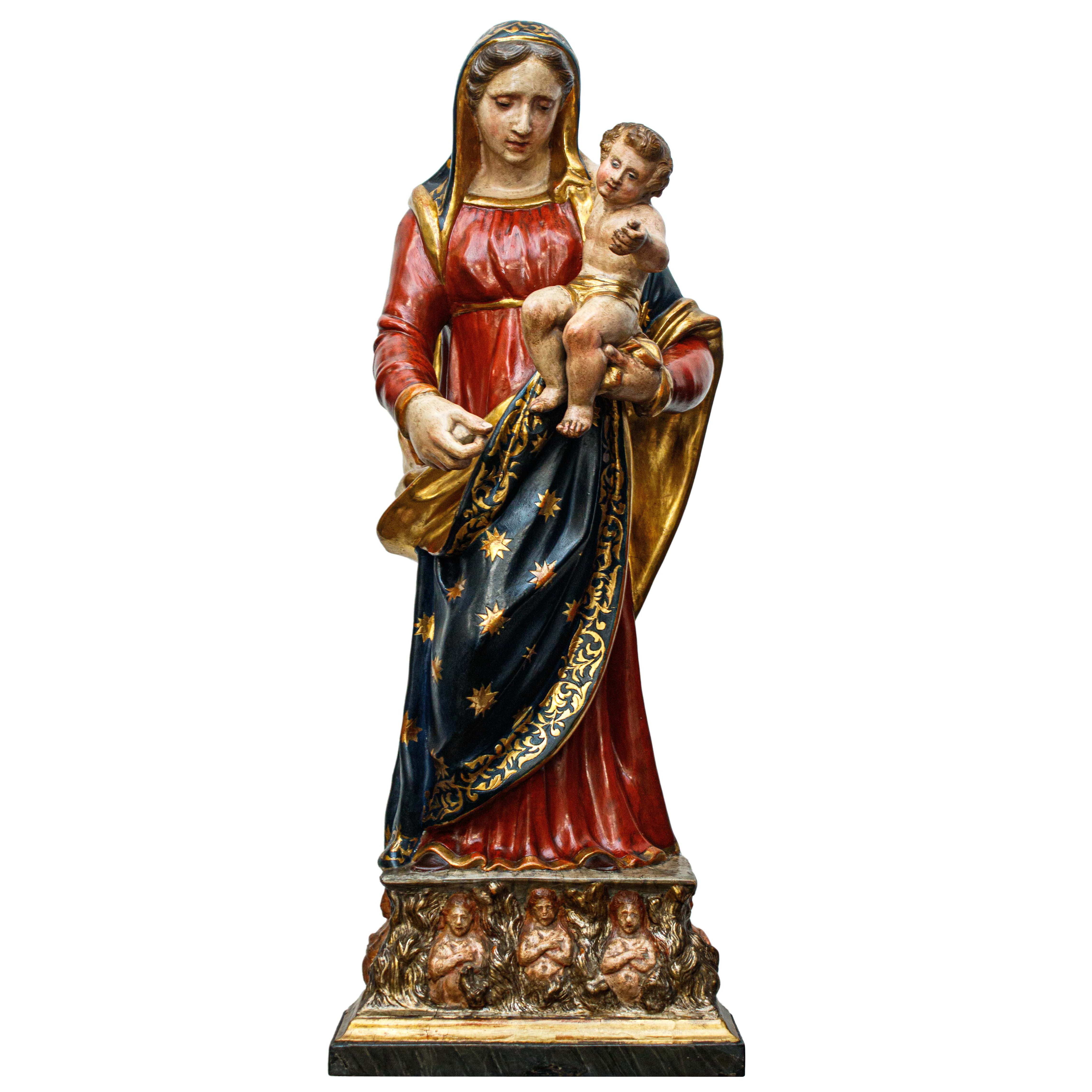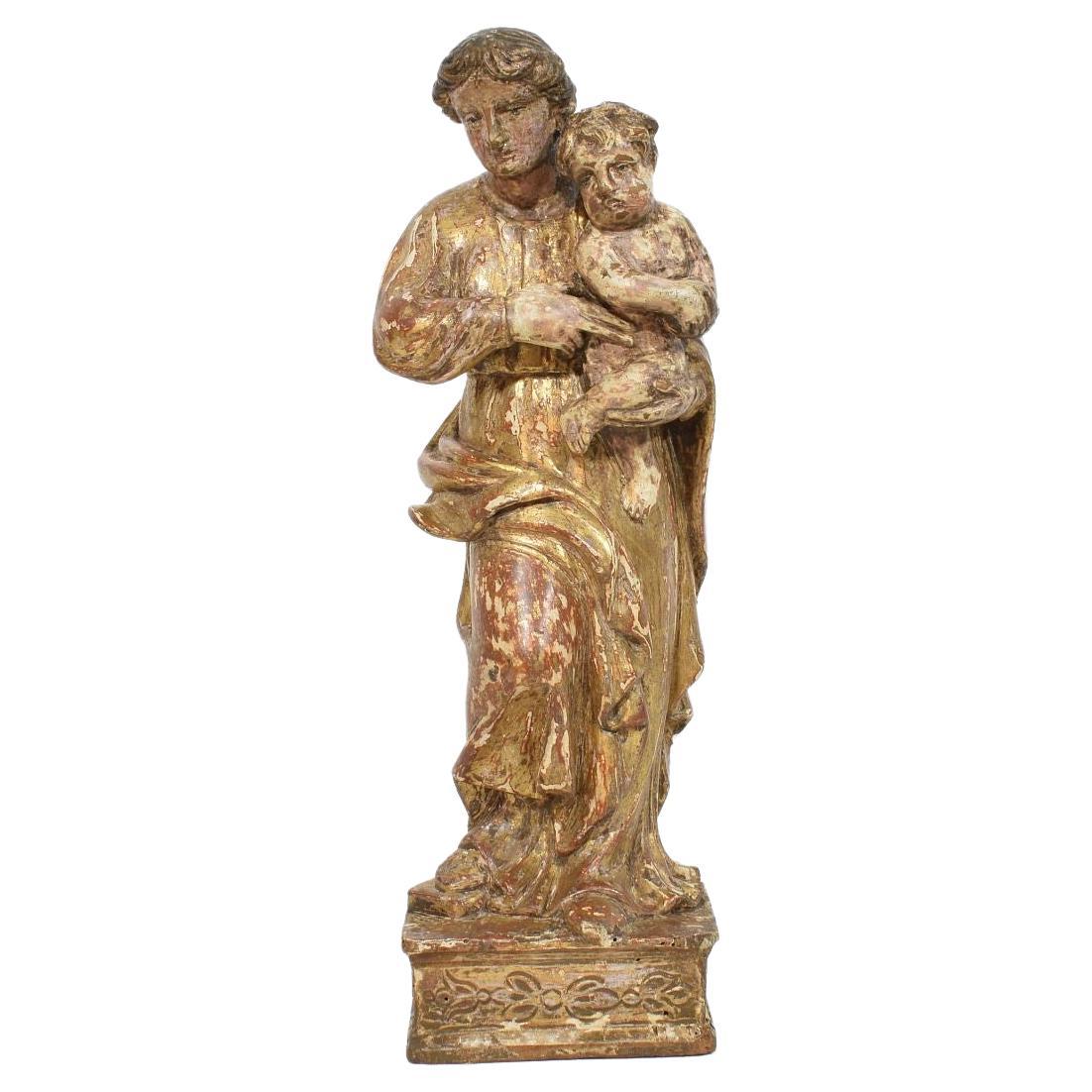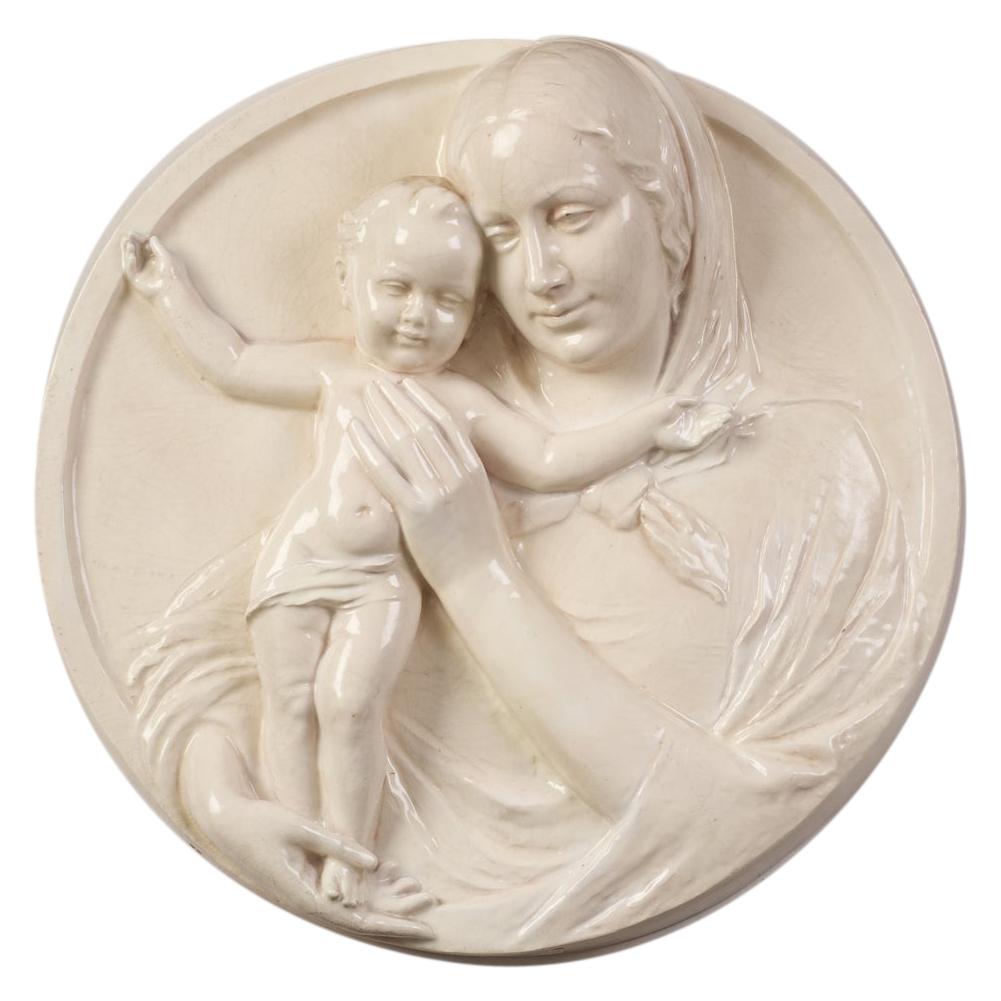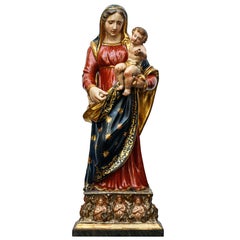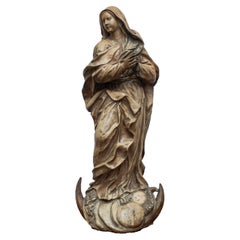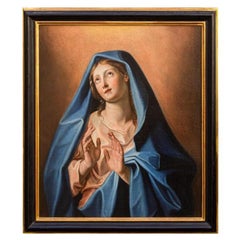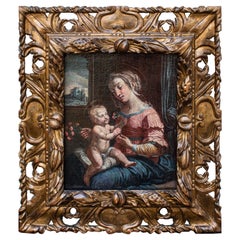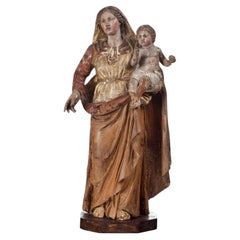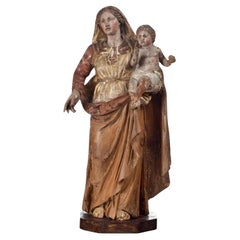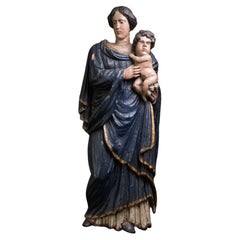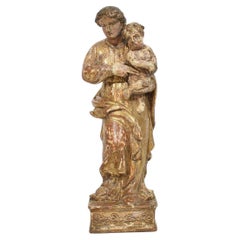Items Similar to 17th Century Madonna with Child from the Impruneta Tondo Polychrome Terracotta
Want more images or videos?
Request additional images or videos from the seller
1 of 14
17th Century Madonna with Child from the Impruneta Tondo Polychrome Terracotta
$5,054.06
£3,741.79
€4,200
CA$6,997.69
A$7,639.81
CHF 4,005.24
MX$92,788.40
NOK 50,018.91
SEK 47,231.19
DKK 31,975.50
About the Item
Tuscan school, 17th century
Madonna with Child - from the Impruneta Tondo
Measures: Polychrome terracotta, 65 x 46 x 10 cm
This polychrome terracotta relief, gently jutting out in a modeled virtuosity that defines a serene Virgin with Child on her lap, takes on the prospect of a bas-relief with a curved shape. The relief is outlined by a border of tripartite leaves interspersed with cherub heads, to define a solid delimitation of the spaces. The enveloping maphorion of the Virgin occupies a large part of the fake blind aedicule that is created; the caressing act of the Son, clinging with one hand to his clothes so as not to fall, thus counterbalances the sinuosity of the Mother's mantle. The surfaces, perfectly smoothed, introduce a staid spiritual climate, encouraged by the sweet general mold.
The group is affected by the iconographic invention of the canonical Madonna and Child painted on a fifteenth-century panel, prototype for the subsequent sculptural transposition. The particular choice of the Madonna seated with her Son resting on her knees became a common type in the Florentine territory in the early fifteenth century, so much so that it was a favorite order among private patrons who ordered small devotional paintings. The present terracotta derives in particular from the marble tondo of Impruneta, replicating an analogous subject but transposed on marble, made by the workshop of Benedetto da Maiano (1442-1497). The tondo, of almost equal dimensions (65 cm high) was placed in the right chapel of the presbytery of the basilica of Santa Maria dell'Impruneta (Florence), on the left wall, above the tomb of Antonio degli Agli. Attributed initially to Benedetto da Rovezzano by Bianchini and Cagnacci, the Tondo was most likely to have a dialogue with the sepulcher of Antonio, whose sarcophagus was made by a (another?) Follower of Benedetto da Maiano. The re-attribution of the Tondo took place on the occasion of the setting up of the Museum of the Church of Santa Maria dell'Impruneta, opened to the public in 1987. It was Ulrich Alexander Middeldorf who attributed it to the more direct, if not contemporary, sequel of the famous Benedetto da Maiano, also on the basis of the comparison with his Madonna and Child of the National Gallery of Art in Washington, executed between the seventies and eighties of the fifteenth century,
Over the centuries, the church of Impruneta abounded in particular artistic works, such as the two tabernacles flanking the altar, made by Michelozzo and Luca della Robbia.
- Dimensions:Height: 25.6 in (65 cm)Width: 18.12 in (46 cm)Depth: 3.94 in (10 cm)
- Materials and Techniques:
- Place of Origin:
- Period:
- Date of Manufacture:17th Century
- Condition:Wear consistent with age and use.
- Seller Location:Milan, IT
- Reference Number:1stDibs: LU5918226733912
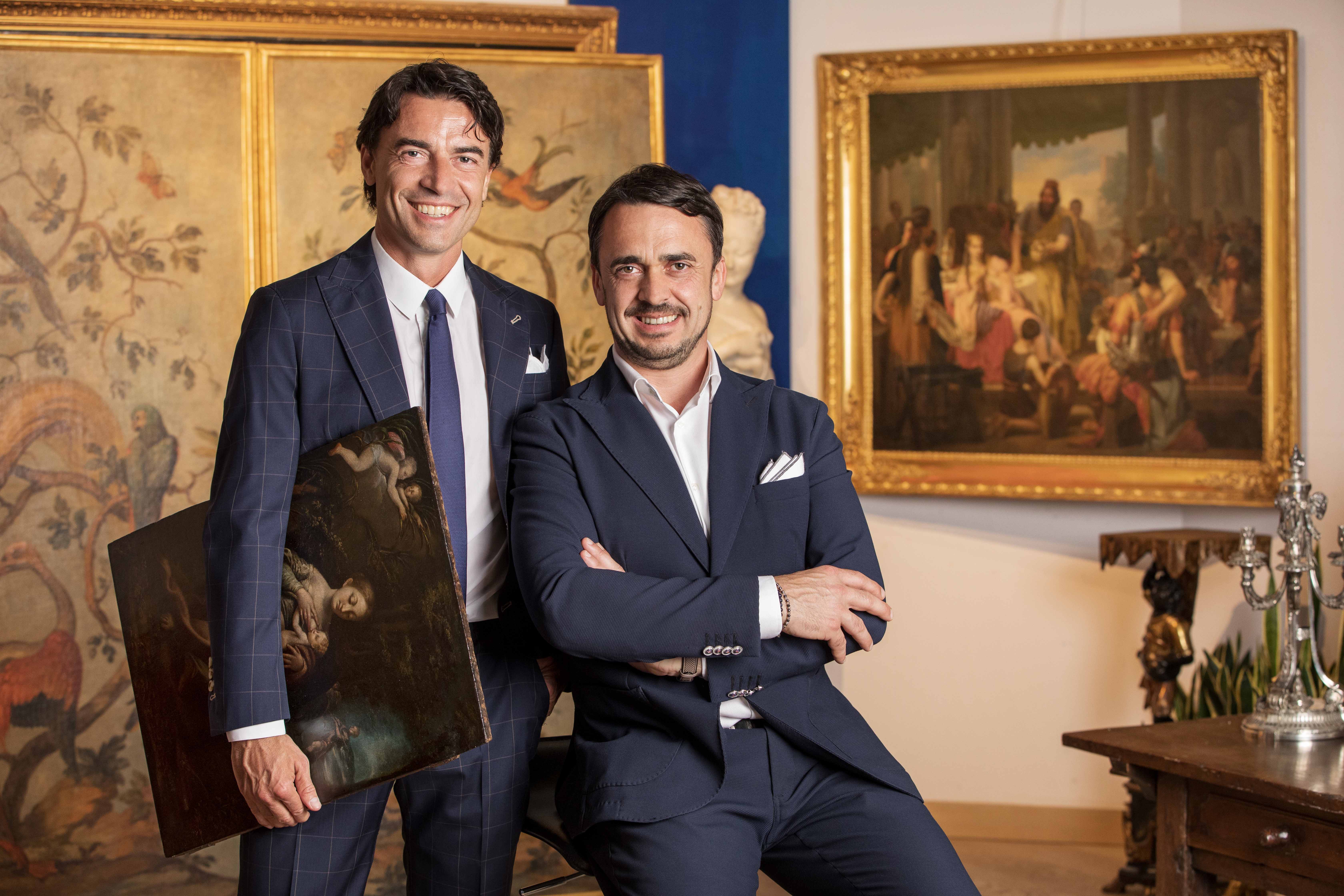
About the Seller
5.0
Vetted Professional Seller
Every seller passes strict standards for authenticity and reliability
Established in 2000
1stDibs seller since 2021
30 sales on 1stDibs
- ShippingRetrieving quote...Shipping from: Milan, Italy
- Return Policy
Authenticity Guarantee
In the unlikely event there’s an issue with an item’s authenticity, contact us within 1 year for a full refund. DetailsMoney-Back Guarantee
If your item is not as described, is damaged in transit, or does not arrive, contact us within 7 days for a full refund. Details24-Hour Cancellation
You have a 24-hour grace period in which to reconsider your purchase, with no questions asked.Vetted Professional Sellers
Our world-class sellers must adhere to strict standards for service and quality, maintaining the integrity of our listings.Price-Match Guarantee
If you find that a seller listed the same item for a lower price elsewhere, we’ll match it.Trusted Global Delivery
Our best-in-class carrier network provides specialized shipping options worldwide, including custom delivery.More From This Seller
View All19th Century Madonna and Child with Souls in Purgatory Papier-Mache Sculpture
Located in Milan, IT
First half of the 19th century
Madonna and Child with souls in Purgatory
Lacquered and gilded papier-mache with polychrome wooden base
cm 96.5 x 37.5 x 28
"At that time I asked the Lord Jesus: 'For whom do I still have to pray?'. Jesus answered me that the following night he would make me known for whom I had to pray. I saw the Custodian Angel, who ordered me to follow him. At a moment I found myself in a foggy place, invaded by fire and, in it, a huge crowd of suffering souls. These souls pray with great fervour, but without effectiveness for themselves: only we can help them. The flames that burned them, they did not touch me. My Guardian Angel did not abandon me for a moment. And I asked those souls what their greatest torment was. And they unanimously answered me that their greatest torment is the ardent desire of God. I read the Madonna who visited the souls of Purgatory. The souls call Mary 'Star of the Sea'. She brings them refreshment ".
(Diary of Sister Faustina Kowalska p. 11)
A Polish religious, Saint Faustina Kowalska (1905-1938) reinterpreted in the pages of her testimony the ancient role of the Virgin as savior and supporter of the souls of Purgatory. The Second Vatican Ecumenical Council established that, assumed into Heaven, the Mother of God should operate a continuous intercession in favor of those children waiting for Paradise who were in the place, quoted for the first time by Pope Gregory the Great...
Category
Antique Early 19th Century Italian Figurative Sculptures
Materials
Paper
18th Century Immaculate Madonna Terracotta Sculpture
Located in Milan, IT
18th century
Immaculate Madonna
Terracotta, 53 x 22 x 20 cm
The work examined depicts the Virgin Mary treated according to the iconography of the Immaculate Virgin
The theme of the Immaculate Conception began to appear in artistic works ever since the debate began, which saw the Franciscans and the ramifications of the Benedictine Order lined up on one side, linked to the thought of Anselmo d'Aosta and Bonaventura da Bagnoregio, and on the other the Dominicans, linked to the discussion offered by Thomas Aquinas...
Category
Antique 18th Century European Figurative Sculptures
Materials
Terracotta
Early 17th Century Roman School Praying Madonna Painting Oil on Canvas
Located in Milan, IT
Roman school, late 16th-early 17th century Praying Madonna
Oil on canvas, 81 x 69 cm
Frame 83 x 95.5 cm
A divine whiteness reverberates with vibrant luster on the maphorion of the present Virgin. The palpable iridescence that structures the thin rosaceous garment, woven with the same fresh light, produces a slight rustle when she takes her hands off. The Madonna in fact takes a prayerful pose, opening her palms to underline her fervent ecstatic intention; the white neck is rendered with perishable fullness of pigments, like the hands, perfectly alive, and the very shiny eyes. With fine shrewdness the artist of the present styles the Virgin's hair with thin white ribbons, exacerbating the purity. An evocative light falls gently on the bust, a materialized sign of divine glory.
The present can be traced back to the late Mannerist climate that prevailed in the capital after the emanation of the Tridentine council (1545-1563). The late Mannerist licenses that can still be seen there, such as the intense lyricism in the stylistic code adopted by the artist, are innervated in the new basic catechetical intent, which at the end of the century produced a certain figurative rigorism. The present, however, still responds to that extraordinary Roman dynamism that raised the capital to a bulwark for the entire mannerist lesson, matched only by a second artistic center, the Florentine one. The engaging carriage of the Virgin reflects the contemporary examples of Giuseppe Valeriano (1542-1596), a Jesuit painter, returning in the Marriage of the Virgin of the Roman Church of Jesus, as well as in the Madonna of Sorrows in the Recanati Altarpiece, equal ardor. But it is in the Assumption of the Virgin painted in four hands with Scipione Pulzone...
Category
Antique Early 17th Century Italian Paintings
Materials
Canvas
16th Century Madonna of the Carnations Painting Oil on Canvas from Raffaello
By Raphael (Raffaello Sanzio da Urbino)
Located in Milan, IT
16th century, by Raffaello Sanzio (Urbino, 1483 - Rome, 1520)
Madonna of the Carnations
Measures: Oil on canvas 38 x 30 - with frame 59 x 52.5 cm
The Madonna dei Garofani made b...
Category
Antique 16th Century Italian Paintings
Materials
Canvas
19th century, from Sassoferrato, Madonna Orante
Located in Milan, IT
19th century, by Giovanni Battista Salvi, known as Sassoferrato (Sassoferrato, 1609 - Rome, 1685)
Praying Madonna
Oil on canvas, 44 x 54 cm
Framed, 88 x 60 cm
Giovanni Battista S...
Category
Antique 19th Century Italian Other Paintings
Materials
Canvas
18th Century Sant'antonio Abate Sculpture in Wood
Located in Milan, IT
18th Century
Sant’Antonio Abate
Wood, cm alt. 61
Base 25 x 17.5 cm
This wooden sculpture depicts Sant’Antoni Abate. Antonio was born in Come i...
Category
Antique 18th Century Italian Figurative Sculptures
Materials
Wood
You May Also Like
Wooden Madonna with Child Baroque Art Italy 17th Century with Export Certificate
Located in Madrid, ES
A Wooden Madonna with child Baroque art, Southern Italy, 17th century.
Measure: H: 71cm
Good condition for the time.
With Export Certificate to USA.
Category
Antique Early 17th Century Italian Baroque Figurative Sculptures
Materials
Wood
Wooden Madonna with Child Baroque Art Italy 17th Century with Export Certificate
Located in Madrid, ES
A Wooden Madonna with child Baroque art, Southern Italy, 17th century.
Measure: H: 71cm
Good condition for the time.
With Export Certificate to USA.
Category
Antique Early 17th Century Italian Baroque Figurative Sculptures
Materials
Wood
18th C, Southern France, Madonna and Child, Carved and Polychrome Wood
Located in Leuven , BE
Although the 18th century, the period of the Enlightenment in France, spawned thinkers who criticised the privileges of the clergy and the truthfulness of certain dogmas, the Roman Catholic faith was very much present in everyday life. Since king Louis XIV had issued the Edict of Fontainebleau in 1685, Protestantism was banned. This Madonna with child illustrates the daily practice of faith. Like many 18th-century Madonna statues...
Category
Antique 18th Century French Figurative Sculptures
Materials
Wood
18th Century Italian Neoclassical Carved Wooden Madonna With Child
Located in Buisson, FR
Beautiful weathered neoclassical Madonna with child. Traces of original color and gilding visible,
Italy, circa 1760-1800.
Weathered small losses and old repairs.
More photo's availa...
Category
Antique 18th Century Italian Neoclassical Religious Items
Materials
Wood
$812 Sale Price
50% Off
Ceramic Madonna with Child High Relief
Located in Alessandria, Piemonte
O/4832 - Beautiful old high-relief white ceramic Madonna with child, signed Friska 1941 -
Sweet smile of mother and child!
Category
Mid-20th Century Italian Aesthetic Movement Figurative Sculptures
Materials
Ceramic
Large Virgin and Child in polychrome wood, Spain, 16th Century
Located in PARIS, FR
Large painted and carved wooden Virgin and Child in the round, representing the Virgin and Child carrying the globe.
The theme of the Virgin and Child is the most represented in all ...
Category
Antique 1630s Spanish Renaissance Figurative Sculptures
Materials
Wood
More Ways To Browse
Marble Sculpture Of A Child
Cherub Heads
Madonna With Child
Polychrome Terracotta
Terracotta Molds
Impruneta Terracotta
Terracotta Child
Terracotta Relief
17th Century Terracotta
Luca Della Robbia
Large Floor Sculpture
Sculpture Centrepiece
1960 Marble Italian Sculpture
Ruth Asawa
African Totem
Corner Sculpture
Glass Sculpture Colorful
Wayne Hand
